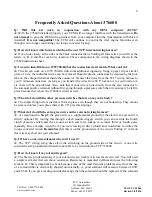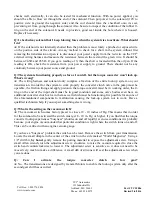
5
Part # TCI-9006
Revised 9/6/2016
Toll Free: 1.888.776.9824
www.tciauto.com
TCI
®
Automotive
151 Industrial Dr.
Ashland, MS 38603
Phone: 662.224.8972
checks well, electrically, it can also be tested for mechanical function. With no power applied, you
should be able to blow air through the end of the solenoid. Then put power to the solenoid (12V to
positive side & ground the negative side) and the coil should force the checkball onto its seat,
preventing air from going through the solenoid. Also be sure to inspect the condition of the rubber 0-
ring on the end of the solenoid. It needs to provide a good seal inside the bore where it is housed.
Replace if necessary.
Q:
I checked my solenoid but I keep blowing fuses when the system tries to activate. What should
I do?
A:
If the solenoid is not internally shorted then the problem is most likely a pinched or exposed wire
on the positive side of the circuit. An easy method to check for a short in the system without first
removing the transmission oil pan is to disconnect your power supply from the red wire on the TCI
®
external wiring harness and measure the resistance between the red and the green wire. It should be
between 24.5
and 26.5
. If you get a reading of 0, then the short is located within the oil pan. If the
reading is OK, check the resistance from your power supply to ground. There should not be any
continuity between your power source and ground.
Q:
The system is functioning properly as far as I can tell, but the torque converter won’t lock up.
What’s wrong?
A:
The wiring harness and solenoid only comprise a fraction of the entire lock-up system on your
transmission. In order for the system to work properly the converter clutch valve in the pump must be
operable, the friction lining and apply piston in the torque converter must be in working order, the 0-
ring on the end of the input shaft must be in good condition and some valve bodies even have an
additional converter clutch valve in them as well which must be functioning.It is possible for anyone of
the aforementioned components to malfunction causing the lock-up system not to work. Have a
qualified technician help if you suspect something else is wrong.
Q:
What is the setting on the vacuum switch?
A:
The vacuum switch comes factory preset to close at 8 - 10 inches of Hg. This means that in order
for the solenoid to be activated the switch must get 8 - 10 in. Hg. or higher. If you find that the torque
converter lockup experiences "busyness" (shuttles on and off rapidly) at cruise conditions it is probably
because your engine vacuum under that particular condition is right where the switch turns on and off.
This can be verified with an engine vacuum gauge.
If you have a "busyness" problem the switch can be reset. Remove the switch from your transmission.
Locate the small dimple in the center of the switch on the side marked "World Magnetics". Using a
1/8" drill bit,
by hand
, gently remove the potting material to expose the adjustment screw. Using a
small Allen wrench, turn the adjustment screw: clockwise to raise the vacuum required to close the
switch and counterclockwise to lower it. The adjustment screw is sensitive so it does not need to be
moved very much to make a difference. A small dab of silicone will seal the adjustment screw when
you are done.
Q:
Can
I
activate
the
torque
converter
clutch
in
low
gear?
A:
No. The transmissions are
designed by General Motors to enable the lock-up system only after the
second gear shift has occurred.

























